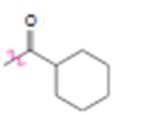
a)

Interpretation:
Whether N,N-dimethylamino group is an activator or deactivator and whether it is a o-, p-director or m-director is to be stated.
Concept introduction:
In
Electron releasing groups, except halogens, normally are activators and ortho & para directors. Electron withdrawing groups normally are deactivators and meta directors. Halogens are ortho & para directing but are deactivating.
To state:
Whether N,N-dimethylamino group is an activator or deactivator and whether it is a, o-, p-director or m-director.
b)

Interpretation:
Whether cyclopentyl group is an activator or deactivator and whether it is an o-, p-director or m-director is to be stated.
Concept introduction:
In aromatic substitution reactions the activating or deactivating and orienting effects of a substituent attached to the benzene ring can be decided from its resonance and inductive effects. The orientation is decided by the resonance effect while the activating or deactivating effect is decided both by resonance and inductive effects. Both effects may reinforce or oppose each other. However the resonance effect is much stronger than the inductive effect.
Electron releasing groups, except halogens, normally are activators and ortho & para directors. Electron withdrawing groups normally are deactivators and meta directors. Halogens are ortho & para directing but are deactivating.
To state:
Whether cyclopentyl group is an activator or deactivator and whether it is an o-, p-director or m-director.
c)

Interpretation:
Whether ethoxy group is an activator or deactivator and whether it is an o-, p-director or m-director is to be stated.
Concept introduction:
In aromatic substitution reactions the activating or deactivating and orienting effects of a substituent attached to the benzene ring can be decided from its resonance and inductive effects. The orientation is decided by the resonance effect while the activating or deactivating effect is decided both by resonance and inductive effects. Both effects may reinforce or oppose each other. However the resonance effect is much stronger than the inductive effect.
Electron releasing groups, except halogens, normally are activators and ortho & para directors. Electron withdrawing groups normally are deactivators and meta directors. Halogens are ortho & para directing but are deactivating.
To state:
Whether ethoxy group is an activator or deactivator and whether it is an o-, p-director or m-director.
d)

Interpretation:
Whether the carbonyl group is an activator or deactivator and whether it is a o-, p-director or m-director is to be stated.
Concept introduction:
In aromatic substitution reactions the activating or deactivating and orienting effects of a substituent attached to the benzene ring can be decided from its resonance and inductive effects. The orientation is decided by the resonance effect while the activating or deactivating effect is decided both by resonance and inductive effects. Both effects may reinforce or oppose each other. However the resonance effect is much stronger than the inductive effect.
Electron releasing groups, except halogens, normally are activators and ortho & para directors. Electron withdrawing groups normally are deactivators and meta directors. Halogens are ortho & para directing but are deactivating.
To state:
Whether carbonyl group is an activator or deactivator and whether it is a o-, p-director or m-director.
Trending nowThis is a popular solution!

Chapter 16 Solutions
ORGANIC CHEMISTRY W/OWL
- presented by Morallen Lig Intermine the hand product for the given mution by adding atoms, bonds, nonhonding diarion panda скуль Step 3: Comp the draw the product Step 2: Agama workup Compithe 429 ملولةarrow_forwardReaction A 0,0arrow_forwardpresented by Morillon Leaning Predict the organic product for the min кусур HSC Adithane carved arnown to come than that to the condon slchroruis in acid in in aquishri with ноюarrow_forward
- 6.15PM Sun Mar 30 K Draw the major product of this reaction. Include any relevant stereochemistry. Ignore inorganic byproducts. Problem 1 of O H [PhзPCH2CH3]*C|¯ NaH Drawing > Q Atoms, Bonds and Draw or tap a nearrow_forward8:17 PM Sun Mar 30 Draw the major product of this reaction. Ignore inorganic byproducts. HSCH2CH2CH2SH, BF3 Probler Drawing Ato Bonds Clarrow_forwardpresented by Mr L How the coprion. (Il Done in no wraction, dew the starting redential) доarrow_forward
- 8:16 PM Sun Mar 30 K Draw the major product of this reaction. Ignore inorganic byproducts. Proble 1. CH3MgBr 2. H3O+ F Drawingarrow_forwardо но оarrow_forwardName the major organic product of the following action of 4-chloro-4-methyl-1-pentanol in neutral pollution 10+ Now the product. The product has a molecular formula f b. In a singly hain, the starting, material again converts into a secule with the molecular kormula CIO. but with comply Draw the major organic structure inhalationarrow_forward
- Macmillan Learning Alcohols can be oxidized by chromic acid derivatives. One such reagent is pyridinium chlorochromate, (C,H,NH*)(CICTO3), commonly known as PCC. Draw the proposed (neutral) intermediate and the organic product in the oxidation of 1-butanol by PCC when carried out in an anhydrous solvent such as CH₂C₁₂. PCC Intermediate OH CH2Cl2 Draw the intermediate. Select Draw Templates More с H Cr о Product Draw the product. Erase Select Draw Templates More H о Erasearrow_forwardIf I have 1-bromopropene, to obtain compound A, I have to add NaOH and another compound. Indicate which compound that would be. A C6H5 CH3arrow_forwardProvide the reagents for the following reactions.arrow_forward

 Organic Chemistry: A Guided InquiryChemistryISBN:9780618974122Author:Andrei StraumanisPublisher:Cengage Learning
Organic Chemistry: A Guided InquiryChemistryISBN:9780618974122Author:Andrei StraumanisPublisher:Cengage Learning Organic ChemistryChemistryISBN:9781305580350Author:William H. Brown, Brent L. Iverson, Eric Anslyn, Christopher S. FootePublisher:Cengage Learning
Organic ChemistryChemistryISBN:9781305580350Author:William H. Brown, Brent L. Iverson, Eric Anslyn, Christopher S. FootePublisher:Cengage Learning


